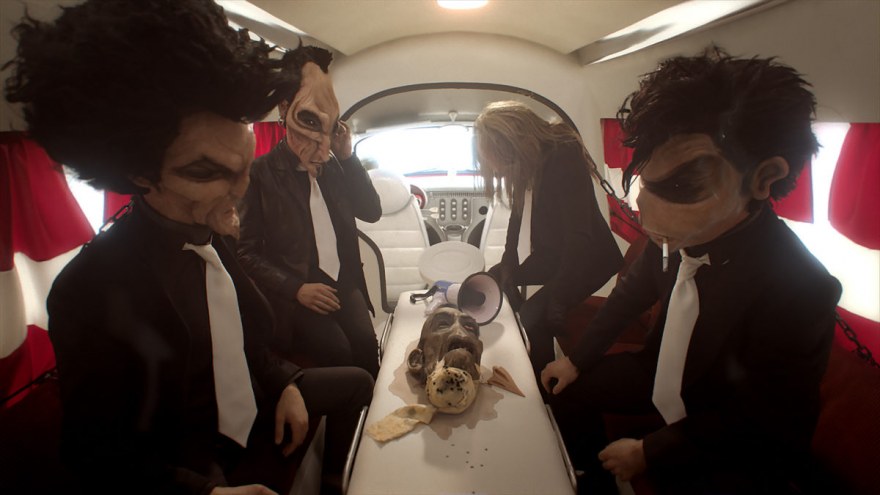Lunch with Splintertime
An interview with Rosto, director of Splintertime
How did you get the vision for Splintertime?
Splintertime is the third in a series of short films featuring the music and characters of Thee Wreckers. Thee Wreckers is my music project and decided to transform some of the songs into films. It’s my way of sharing my music with the world and showing you what it looks like to me. While writing the music, my head is already filled with pictures and ideas. If you listen very very closely to a piece of music, you will discover its landscapes and characters. Sometimes the lyrics will trigger something, sometimes the melodies will. It’s very similar to making a film but at the same time completely different. In this case, the song Splintertime and the ending of the previous Wreckers-film Lonely Bones together gave me the idea for the film in its roughest brush strokes.
Why were you interested in music video?
I’m interested in music as the motor of a film. I try to make films that work like music. Communicating on a purely emotional level. In a way, these films are like Fantasia: an interpretation of the music but more than just an illustration of the sounds. You can “get” music without “understanding” it. I find that terrifically interesting.
Music videos are, however great some of them are, in the end adverts for selling records. I find that less interesting and since I have no records to sell these films are not music videos.
What was first: the Wreckers song, your clip, or were you working on both at the same time?
These Wreckers films are inspired by the songs. That’s how it starts. But not like a music video where the music is set in stone. After the idea was triggered by the song, the song becomes raw material: the song is being restructured and rebuild together with the other elements of the film until they grow together into one body. An obvious example would be that I’d get rid of the lead vocals because there is already something else in the picture “taking the lead”. But it would theoretically also be possible to get rid of (parts of) the song because the picture made it obsolete.
Have you got other projects in music video?
To me, music is the mother of all arts. It’s the driving force in my work. I directed a few music videos in my younger years, but lost interest in the industry. I still need to have a musical sense first when I start a project. It’s the emotional core and a sense of timing that I need before anything else can start. I am probably of the generation where musical is a visual thing anyway. I get visuals when listening to music. The next thing I want to do is the follow up to Splintertime, the fourth and final Thee Wreckers short of the series.
Can you describe the technical aspects of how you put together the universe of Splintertime?
That’s a simple question with a very complicated answer. Different techniques were applied. I suppose we call it hybrid. In short you could say that live action performers were recorded and then animated/manipulated after; half real life action sets were later finished with 3D or 2D elements. It’s a collage.
How did you design the timeline of Splintertime? What do you think of the time loop concept?
Time is an important factor, hence the title. Man invented time and space because otherwise everything would be happening at the same time in the same place, the philosopher Kant said. In Splintertime there is originally no sense of time nor space. As the element of time gets introduced it proves to be elastic and unreliable. It gets condensed as well as expanded. There is slow motion but also fast motion. But the space seems to be doing the same.
Are you sensitive to the realms of imagination? Do you like worlds with logic and rules of their own?
“Reality is overrated, but it’s the only place where you can get a decent meal” Groucho Marx once said. I agree. I do not find so-called reality more convincing than anyone’s imagination. It is all equally real as it is unreal. Dreams are personal experiences just as well as everyday waking life. And so is the marvelous music that made you cry, or that abstract painting that you couldn’t stop watching. All these experiences are the building blocks of who we are, deep down. No matter how hard it sometimes tries to mimic or pretend to be “real”, film is by definition not real, but can be a very powerful way of communication between one soul and another.
Do you enjoy Odd, Burlesque, or both?
I enjoy anything that makes me feel something.
There were times when Splintertime made me think of Near Death Experience. Was it one of the themes you had in mind when working on the film?
Splintertime consciously deals with duality but also the mutual relationship between seeming opposites: death vs. birth, fast vs. slow, dark vs. light etc. Not only do they need each other, they are usually two sides of the same coin and sometimes even interchangeable. In the end it’s all down to the eye of the beholder.
Splintertime was produced in France. According to you, what does French production bring to short film that no other would?
Splintertime was a co-production between The Netherlands, France and Belgium. France especially has been very good to me and my work because it’s a cinephile country and having your own voice (being an author) is considered a good thing, unlike in some other countries. Besides, my partners in crime are my friends at the Paris based company Autour de Minuit, who have not only been involved in the production of my recent films but are also the distributors of my entire oeuvre.
Programmes for viewing Splintertime: National Competition F2 and School screenings SCO.
More info This will be the world premiere of Splintertime.









